Exercise for preventing falls in older people living in the community
- PMID: 30703272
- PMCID: PMC6360922
- DOI: 10.1002/14651858.CD012424.pub2
Exercise for preventing falls in older people living in the community
Abstract
Background: At least one-third of community-dwelling people over 65 years of age fall each year. Exercises that target balance, gait and muscle strength have been found to prevent falls in these people. An up-to-date synthesis of the evidence is important given the major long-term consequences associated with falls and fall-related injuries OBJECTIVES: To assess the effects (benefits and harms) of exercise interventions for preventing falls in older people living in the community.
Search methods: We searched CENTRAL, MEDLINE, Embase, three other databases and two trial registers up to 2 May 2018, together with reference checking and contact with study authors to identify additional studies.
Selection criteria: We included randomised controlled trials (RCTs) evaluating the effects of any form of exercise as a single intervention on falls in people aged 60+ years living in the community. We excluded trials focused on particular conditions, such as stroke.
Data collection and analysis: We used standard methodological procedures expected by Cochrane. Our primary outcome was rate of falls.
Main results: We included 108 RCTs with 23,407 participants living in the community in 25 countries. There were nine cluster-RCTs. On average, participants were 76 years old and 77% were women. Most trials had unclear or high risk of bias for one or more items. Results from four trials focusing on people who had been recently discharged from hospital and from comparisons of different exercises are not described here.Exercise (all types) versus control Eighty-one trials (19,684 participants) compared exercise (all types) with control intervention (one not thought to reduce falls). Exercise reduces the rate of falls by 23% (rate ratio (RaR) 0.77, 95% confidence interval (CI) 0.71 to 0.83; 12,981 participants, 59 studies; high-certainty evidence). Based on an illustrative risk of 850 falls in 1000 people followed over one year (data based on control group risk data from the 59 studies), this equates to 195 (95% CI 144 to 246) fewer falls in the exercise group. Exercise also reduces the number of people experiencing one or more falls by 15% (risk ratio (RR) 0.85, 95% CI 0.81 to 0.89; 13,518 participants, 63 studies; high-certainty evidence). Based on an illustrative risk of 480 fallers in 1000 people followed over one year (data based on control group risk data from the 63 studies), this equates to 72 (95% CI 52 to 91) fewer fallers in the exercise group. Subgroup analyses showed no evidence of a difference in effect on both falls outcomes according to whether trials selected participants at increased risk of falling or not.The findings for other outcomes are less certain, reflecting in part the relatively low number of studies and participants. Exercise may reduce the number of people experiencing one or more fall-related fractures (RR 0.73, 95% CI 0.56 to 0.95; 4047 participants, 10 studies; low-certainty evidence) and the number of people experiencing one or more falls requiring medical attention (RR 0.61, 95% CI 0.47 to 0.79; 1019 participants, 5 studies; low-certainty evidence). The effect of exercise on the number of people who experience one or more falls requiring hospital admission is unclear (RR 0.78, 95% CI 0.51 to 1.18; 1705 participants, 2 studies, very low-certainty evidence). Exercise may make little important difference to health-related quality of life: conversion of the pooled result (standardised mean difference (SMD) -0.03, 95% CI -0.10 to 0.04; 3172 participants, 15 studies; low-certainty evidence) to the EQ-5D and SF-36 scores showed the respective 95% CIs were much smaller than minimally important differences for both scales.Adverse events were reported to some degree in 27 trials (6019 participants) but were monitored closely in both exercise and control groups in only one trial. Fourteen trials reported no adverse events. Aside from two serious adverse events (one pelvic stress fracture and one inguinal hernia surgery) reported in one trial, the remainder were non-serious adverse events, primarily of a musculoskeletal nature. There was a median of three events (range 1 to 26) in the exercise groups.Different exercise types versus controlDifferent forms of exercise had different impacts on falls (test for subgroup differences, rate of falls: P = 0.004, I² = 71%). Compared with control, balance and functional exercises reduce the rate of falls by 24% (RaR 0.76, 95% CI 0.70 to 0.81; 7920 participants, 39 studies; high-certainty evidence) and the number of people experiencing one or more falls by 13% (RR 0.87, 95% CI 0.82 to 0.91; 8288 participants, 37 studies; high-certainty evidence). Multiple types of exercise (most commonly balance and functional exercises plus resistance exercises) probably reduce the rate of falls by 34% (RaR 0.66, 95% CI 0.50 to 0.88; 1374 participants, 11 studies; moderate-certainty evidence) and the number of people experiencing one or more falls by 22% (RR 0.78, 95% CI 0.64 to 0.96; 1623 participants, 17 studies; moderate-certainty evidence). Tai Chi may reduce the rate of falls by 19% (RaR 0.81, 95% CI 0.67 to 0.99; 2655 participants, 7 studies; low-certainty evidence) as well as reducing the number of people who experience falls by 20% (RR 0.80, 95% CI 0.70 to 0.91; 2677 participants, 8 studies; high-certainty evidence). We are uncertain of the effects of programmes that are primarily resistance training, or dance or walking programmes on the rate of falls and the number of people who experience falls. No trials compared flexibility or endurance exercise versus control.
Authors' conclusions: Exercise programmes reduce the rate of falls and the number of people experiencing falls in older people living in the community (high-certainty evidence). The effects of such exercise programmes are uncertain for other non-falls outcomes. Where reported, adverse events were predominantly non-serious.Exercise programmes that reduce falls primarily involve balance and functional exercises, while programmes that probably reduce falls include multiple exercise categories (typically balance and functional exercises plus resistance exercises). Tai Chi may also prevent falls but we are uncertain of the effect of resistance exercise (without balance and functional exercises), dance, or walking on the rate of falls.
Conflict of interest statement
Several authors (CS, AT, SH, KH and SL) are currently running trials of fall prevention interventions; including the following ongoing trials in this review (ACTRN 12615000138583; ACTRN 12615000865516; ISRCTN71002650). These trials are all funded by national grant agencies.
No review author was involved in study selection or processing of any trials in which they were or are involved.
CS is an author of several trials considered in this review, including four included trials (Merom 2016; Sherrington 2014; Vogler 2009; Voukelatos 2015). NF has no known conflicts of interest. GW has no known conflicts of interest. AT has no known conflicts of interest. ZM has no known conflicts of interest. KH is an author of several trials considered in this review, including one included trial (Sherrington 2014). LC is an author of several trials considered in this review, including two included trials (Clemson 2010; Clemson 2012). SH has no known conflicts of interest. SL is lead author of the ProFaNE consensus for falls guidance and is an author of one of the trials considered in this review.
Figures














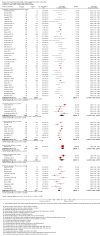



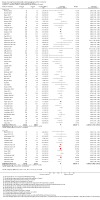
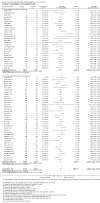

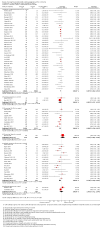













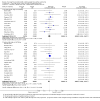
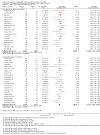
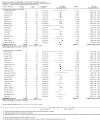


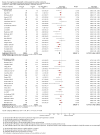
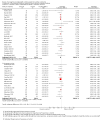

























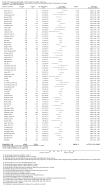








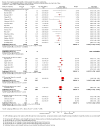

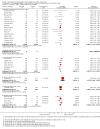








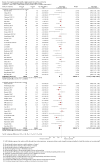

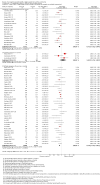

Update of
References
References to studies included in this review
Almeida 2013 {published data only}
Ansai 2015 {published data only (unpublished sought but not used)}
-
- Ansai JH, Rebelatto JR. Effect of two physical exercise protocols on cognition and depressive symptoms in oldest‐old people: A randomized controlled trial. Geriatrics and Gerontology International 2015;15(9):1127‐34. - PubMed
Arantes 2015 {published data only (unpublished sought but not used)}
-
- Arantes PM, Dias JM, Fonseca FF, Oliveira AM, Oliveira MC, Pereira LS, et al. Effect of a program based on balance exercises on gait, functional mobility, fear of falling, and falls in prefrail older women: a randomized clinical trial. Topics in Geriatric Rehabilitation 2015;31(2):113‐20. [DOI: 10.1097/TGR.0000000000000056] - DOI
Arkkukangas 2015 {published and unpublished data}
-
- Arkkukangas M. Fall data [personal communication]. Email to: Z. Michaleff. 18 August 2015.
Ballard 2004 {published data only (unpublished sought but not used)}
-
- Ballard JE, McFarland C, Wallace LS, Holiday DB, Roberson G. The effect of 15 weeks of exercise on balance, leg strength, and reduction in falls in 40 women aged 65 to 89 years. Journal of the American Medical Women's Association 2004;59(4):255‐61. [MEDLINE: ] - PubMed
Barker 2016 {published data only}
-
- Barker AL, Talevski J, Bohensky MA, Brand CA, Cameron PA, Morello RT. Feasibility of Pilates exercise to decrease falls risk: a pilot randomized controlled trial in community‐dwelling older people. Clinical Rehabilitation 2016;30(10):984‐96. - PubMed
Barnett 2003 {published data only}
-
- Barnett A, Smith B, Lord SR, Williams M, Baumand A. Community‐based group exercise improves balance and reduces falls in at‐risk older people: a randomised controlled trial. Age and Ageing 2003;32(4):407‐14. - PubMed
Beyer 2007 {published data only (unpublished sought but not used)}
-
- Beyer N, Simonsen L, Bulow J, Lorenzen T, Jensen D V, Larsen L, et al. Old women with a recent fall history show improved muscle strength and function sustained for six months after finishing training. Aging Clinical and Experimental Research 2007;19(4):300‐9. - PubMed
Boongrid 2017 {published data only}
-
- Boongrid C, Keesukphan P, Phiphadthakusolkul S, Rattanasiri S, Thakkinstian A. Effects of a simple home‐based exercise program on fall prevention in older adults: A 12‐month primary care setting, randomized controlled trial. Geriatrics and Gerontology International 2017;17(11):2157‐63. [DOI: 10.1111/ggi.13052] - DOI - PubMed
Brown 2002 {published data only}
-
- Brown A P. Reducing falls in elderly people: A review of exercise interventions. Physiotherapy Theory and Practice 1999;15(2):59‐68.
-
- Brown AI. Functional Adaptation to Exercise in Elderly Subjects [thesis]. Perth (Australia): Curtin University of Technology, 2002 (espace.curtin.edu.au/handle/20.500.11937/401).
-
- Piotrowski A, Cole J, Allison G. The influence of functional ability and physical and social intervention on falls in elderly subjects. XVIth Congress of the International Association of Gerontology; 1997 August 19‐23; Adelaide (Australia). 2002.
Buchner 1997 {published data only}
-
- Buchner DM, Cress ME, Lateur BJ, Esselman PC, Margherita AJ, Price R, et al. The effect of strength and endurance training on gait, balance, fall risk, and health services use in community‐living older adults. Journals of Gerontology. Series A, Biological Sciences and Medical Sciences 1997;52(4):M218‐24. - PubMed
-
- Buchner DM, Cress ME, Wagner EH, Lateur BJ. The role of exercise in fall prevention: Developing targeting criteria for exercise programs. In: Vellas B, Toupet M, Rubenstein L, Albarede JL, Christen Y editor(s). Falls, Balance and Gait Disorders in the Elderly. Amsterdam: Elsevier, 1992:55‐68.
-
- Buchner DM, Cress ME, Wagner EH, Lateur BJ, Price R, Abrass IB. The Seattle FICSIT/MoveIt study: the effect of exercise on gait and balance in older adults. Journal of the American Geriatrics Society 1993;41(3):321‐5. - PubMed
Bunout 2005 {published and unpublished data}
-
- Bunout D. [Personal communication]. Personal communication reported by Gillespie 2012.
-
- Bunout D, Barrera G, Avendano M, Maza P, Gattas V, Leiva L, et al. Results of a community‐based weight‐bearing resistance training programme for healthy Chilean elderly subjects. Age and Ageing 2005;34(1):80‐3. - PubMed
Campbell 1997 {published data only}
-
- Campbell AJ, Robertson MC, Gardner MM, Norton RN, Buchner DM. Falls prevention over 2 years: a randomized controlled trial in women 80 years and older. Age and Ageing 1999;28(6):513‐8. - PubMed
-
- Campbell AJ, Robertson MC, Gardner MM, Norton RN, Buchner DM. Psychotropic medication withdrawal and a home‐based exercise program to prevent falls: a randomized, controlled trial. Journal of the American Geriatrics Society 1999;47(7):850‐3. - PubMed
-
- Gardner M. Home‐based exercises to prevent falls in elderly women. New Zealand Journal of Physiotherapy 1998;26(3):6.
-
- Gardner MM, Buchner DM, Robertson MC, Campbel AJ. Practical implementation of an exercise‐based falls prevention programme. Age and Ageing 2001;30(1):77‐83. - PubMed
Carter 2002 {published data only (unpublished sought but not used)}
-
- Carter ND, Khan KM, Petit MA, Heinonen A, Waterman C, Donaldson MG, et al. Results of a 10 week community based strength and balance training programme to reduce fall risk factors: a randomised controlled trial in 65‐75 year old women with osteoporosis. British Journal of Sports Medicine 2001;35(5):348‐51. - PMC - PubMed
Cerny 1998 {published and unpublished data}
-
- Cerny K. [Personal communication]. Personal communication reported by Gillespie 2012.
-
- Cerny K, Blanks R, Mohamed O, Schwab D, Robinson B, Russo A, et al. The effect of a multidimensional exercise program on strength, range of motion, balance and gait in the well elderly. Gait and Posture 1998;7(2):185‐6.
Clegg 2014 {published and unpublished data}
-
- Clegg A. Faller outcome data [personal communication]. Email to: C. West. 4 June 2018.
Clemson 2010 {published data only}
-
- Clemson L, Singh MF, Bundy A, Cumming RG, Weissel E, Munro J, et al. LiFE Pilot Study: a randomised trial of balance and strength training embedded in daily life activity to reduce falls in older adults. Australian Occupational Therapy Journal 2010;57(1):42‐50. - PubMed
Clemson 2012 {published data only}
Cornillon 2002 {published data only}
-
- Cornillon E, Blanchon MA, Ramboatsisetraina P, Braize C, Beauchet O, Dubost V. Effectiveness of falls prevention strategies for elderly subjects who live in the community with performance assessment of physical activities (before‐after) [Impact d'un programme de prevention multidisciplinaire de la chute chez le sujet age autonome vivant a domicile, avec analyse avant‐apres des performances physiques]. Annales de Readaptation et de Medecine Physique 2002;45(9):493‐504. - PubMed
Dadgari 2016 {published and unpublished data}
-
- Dadgari A. Fall outcomes [personal communication]. Email to: N Fairhall. 29 August 2017.
-
- Dadgari A. Number of males / females [personal communication]. Email to: C Ng. 4 September 2017.
-
- Dadgari A. Number of study participants per health centre [personal communication]. Email to: C Sherrington. 1 January 2018.
Dangour 2011 {published data only (unpublished sought but not used)}
-
- Dangour AD, Albala C, Aedo C, Elbourne D, Grundy E, Walker D, et al. A factorial‐design cluster randomised controlled trial investigating the cost‐effectiveness of a nutrition supplement and an exercise programme on pneumonia incidence, walking capacity and body mass index in older people living in Santiago, Chile: the CENEX study protocol. Nutrition Journal 2007;6:14. - PMC - PubMed
-
- ISRCTN48153354. Cost‐effectiveness of nutritional supplementation and exercise programme among older people in Santiago, Chile. controlled‐trials.com/ISRCTN48153354 (first received 22 July 2005).
-
- Walker DG, Aedo C, Albala C, Allen E, Dangour AD, Elbourne D, et al. Methods for economic evaluation of a factorial‐design cluster randomised controlled trial of a nutrition supplement and an exercise programme among healthy older people living in Santiago, Chile: the CENEX study. BMC Health Services Research 2009;9:85. - PMC - PubMed
Davis 2011 {published data only (unpublished sought but not used)}
Day 2002 {published data only}
-
- Fitzharris MP, Day L, Lord SR, Gordon I, Fildes B. The Whitehorse NoFalls trial: effects on fall rates and injurious fall rates. Age and Ageing 2010;39(6):728‐33. - PubMed
Day 2015 {published data only}
-
- Day L, Hill KD, Stathakis VZ, Flicker L, Segal L, Cicuttini F, et al. Impact of Tai‐Chi on falls among preclinically disabled older people: a randomized controlled trial. Journal of the American Medical Directors Association 2015;16(5):420‐6. - PubMed
Duque 2013 {published data only (unpublished sought but not used)}
Ebrahim 1997 {published data only}
-
- Ebrahim S, Thompson PW, Baskaran V, Evans K. Randomized placebo‐controlled trial of brisk walking in the prevention of postmenopausal osteoporosis. Age and Ageing 1997;26(4):253‐60. - PubMed
El‐Khoury 2015 {published data only}
Fiatarone 1997 {published data only}
-
- Fiatarone MA, O'Neill EF, Doyle Ryan N, Clements K. Efficacy of home‐based resistance training in frail elders. World Congress of Gerontology, 16th Congress of the International Association of Gerontology; 1997 August 19‐23; Adelaide, South Australia. 1997:323 (abstract no. 985). [CN‐00847936]
Freiberger 2007 {published data only}
-
- Freiberger E, Haberle L, Spirduso WW, Zijlstra GA. Long‐term effects of three multicomponent exercise interventions on physical performance and fall‐related psychological outcomes in community‐dwelling older adults: a randomized controlled trial. Journal of the American Geriatrics Society 2012;60(3):437‐46. - PubMed
-
- Freiberger E, Menz H B, Abu‐Omar K, Rutten A. Preventing falls in physically active community‐dwelling older people: a comparison of two intervention techniques. Gerontology 2007;53(5):298‐305. - PubMed
Gill 2016 {published data only}
Grahn Kronhed 2009 {published data only (unpublished sought but not used)}
-
- Grahn Kronhed AC, Hallberg I, Odkvist L, Moller M. Effect of training on health‐related quality of life, pain and falls in osteoporotic women. Advances in Physiotherapy 2009;11(3):154‐65.
Gschwind 2015 {published data only (unpublished sought but not used)}
Haines 2009 {published data only}
-
- Haines TP, Russell T, Brauer SG, Erwin S, Lane P, Urry S, et al. Effectiveness of a video‐based exercise programme to reduce falls and improve health‐related quality of life among older adults discharged from hospital: a pilot randomized controlled trial. Clinical Rehabilitation 2009;23(11):973‐85. - PubMed
Halvarsson 2013 {published data only (unpublished sought but not used)}
-
- Halvarsson A, Franzén E, Farén E, Olsson E, Oddsson L, Ståhle A. Long‐term effects of new progressive group balance training for elderly people with increased risk of falling ‐ a randomized controlled trial. Clinical Rehabilitation 2013;27(5):450‐8. - PubMed
-
- Halvarsson A, Oddsson L, Olsson E, Farén E, Pettersson A, Ståhle A. Effects of new, individually adjusted, progressive balance group training for elderly people with fear of falling and tend to fall: a randomized controlled trial.[Erratum in Clinical Rehabilitation 2012 Nov;26(11):1055]. Clinical Rehabilitation 2011;25(11):1021‐31. - PubMed
Halvarsson 2016 {published data only (unpublished sought but not used)}
-
- Halvarsson A, Franzén E, Ståhle A. Balance training with multi‐task exercises improves fall‐related self‐efficacy, gait, balance performance and physical function in older adults with osteoporosis: a randomized controlled trial. Clinical Rehabilitation 2015;29(4):365‐75. - PubMed
-
- Halvarsson A, Oddsson L, Franzén E, Ståhle A. Long‐term effects of a progressive and specific balance‐training programme with multi‐task exercises for older adults with osteoporosis: a randomized controlled study. Clinical Rehabilitation 2016;30(11):1049‐59. - PubMed
Hamrick 2017 {published and unpublished data}
-
- Hamrick I. Sample size, instructor:participant ratio and faller outcome data [personal communication]. Email to: N Fairhall. 14 December 2017, 19 May 2018.
-
- Hamrick I, Mross P, Christopher N, Smith PD. Yoga's effect on falls in rural, older adults. Complementary Therapies in Medicine 2017;35:57‐63. - PubMed
Hauer 2001 {published and unpublished data}
-
- Hauer K. [Personal communication]. Personal communication reported by Gillespie 2012.
-
- Hauer K, Pfisterer M, Schuler M, Bartsch P, Oster P. Two years later: a prospective long‐term follow‐up of a training intervention in geriatric patients with a history of severe falls. Archives of Physical Medicine and Rehabilitation 2003;84(10):1426‐32. - PubMed
-
- Hauer K, Rost B, Rutschle K, Opitz H, Specht N, Bartsch P, et al. Exercise training for rehabilitation and secondary prevention of falls in geriatric patients with a history of injurious falls. Journal of the American Geriatrics Society 2001;49(1):10‐20. - PubMed
-
- Hauer K, Specht N, Schuler M, Bartsch P, Oster P. Intensive physical training in geriatric patients after severe falls and hip surgery. Age and Ageing 2002;31(1):49‐57. - PubMed
-
- Oster P, Hauer K, Specht N, Rost B, Baertsch P, Schlierf G. Strength and coordination training for prevention of falls in the elderly [Kraft‐ und koordinationstraining zur sturzpravention im alter]. Zeitschrift fur Gerontologie und Geriatrie 1997;30(4):289‐92. - PubMed
Helbostad 2004 {published data only}
-
- Helbostad JL, Moe‐Nilssen R, Sletvold O. Comparison of two types of exercise regimes on selected functional abilities for community‐dwelling elderly at risk of falling. XVI Conference of the International Society for Postural Gait Research; 2003 March 23‐27; Sydney (Australia). 2004.
-
- Helbostad JL, Sletvold O, Moe‐Nilssen R. Effects of home exercises and group training on functional abilities in home‐dwelling older persons with mobility and balance problems. A randomized study. Aging Clinical and Experimental Research 2004;16(2):113‐21. - PubMed
-
- Helbostad JL, Sletvold O, Moe‐Nilssen R. Home training with and without additional group training in physically frail old people living at home: effect on health‐related quality of life and ambulation. Clinical Rehabilitation 2004;18(5):498‐508. - PubMed
Hirase 2015 {published data only (unpublished sought but not used)}
-
- Hirase T, Inokuchi S, Matsusaka N, Okita M. Effects of a balance training program using a foam rubber pad in community‐based older adults: a randomized controlled trial. Journal of Geriatric Physical Therapy 2015;38(2):62‐70. - PubMed
Huang 2010 {published data only (unpublished sought but not used)}
-
- Huang HC, Liu CY, Huang YT, Kernohan WG. Community‐based interventions to reduce falls among older adults in Taiwan ‐ long time follow‐up randomised controlled study. Journal of Clinical Nursing 2010;19(7‐8):959‐68. - PubMed
Hwang 2016 {published data only}
-
- Hwang HF, Chen SJ, Lee‐Hsieh J, Chien DK, Chen CY, Lin MR. Effects of home‐based tai chi and lower extremity training and self‐practice on falls and functional outcomes in older fallers from the emergency department ‐ a randomized controlled trial. Journal of the American Geriatrics Society 2016;64(3):518‐25. - PubMed
Iliffe 2015 {published data only}
-
- Gawler S, Skelton DA, Dinan‐Young S, Masud T, Morris RW, Griffin M, et al. Reducing falls among older people in general practice: The ProAct65+ exercise intervention trial. Archives of Gerontology and Geriatrics 2016;67:46‐54. - PubMed
-
- Iliffe S, Kendrick D, Morris R, Masud T, Gage H, Skelton D, et al. Multicentre cluster randomised trial comparing a community group exercise programme and home‐based exercise with usual care for people aged 65 years and over in primary care. Health Technology Assessment 2014;18(49):vii‐xxvii, 1‐105. - PMC - PubMed
Irez 2011 {published data only}
Iwamoto 2009 {published data only}
-
- Iwamoto J, Suzuki H, Tanaka K, Kumakubo T, Hirabayashi H, Miyazaki Y, et al. Preventative effect of exercise against falls in the elderly: A randomized controlled trial. Osteoporosis International 2009;20(7):1233‐40. - PubMed
Kamide 2009 {published data only}
-
- Kamide N, Shiba Y, Shibata H. Effects on balance, falls, and bone mineral density of a home‐based exercise program without home visits in community‐dwelling elderly women: a randomized controlled trial. Journal of Physiological Anthropology 2009;28(3):115‐22. - PubMed
Karinkanta 2007 {published data only (unpublished sought but not used)}
-
- Karinkanta S, Heinonen A, Sievanen H, Uusi‐Rasi K, Pasanen M, Ojala K, et al. A multi‐component exercise regimen to prevent functional decline and bone fragility in home‐dwelling elderly women: randomized, controlled trial. Osteoporosis International 2007;18(4):453‐62. - PubMed
-
- Karinkanta S, Kannus P, Uusi‐Rasi K, Heinonen A, Sievanen H. Combined resistance and balance‐jumping exercise reduces older women's injurious falls and fractures: 5‐year follow‐up study. Age and Ageing 2015;44(5):784‐9. - PubMed
-
- Karinkanta S, Nupponen R, Heinonen A, Pasanen M, Sievanen H, Uusi‐Rasi K, et al. Effects of exercise on health‐related quality of life and fear of falling in home‐dwelling older women. Journal of Aging and Physical Activity 2012;20(2):198‐214. - PubMed
Kemmler 2010 {published data only}
-
- Kemmler W, Stengel S, Engelke K, Haberle L, Kalender WA. Exercise effects on bone mineral density, falls, coronary risk factors, and health care costs in older women: the randomized controlled senior fitness and prevention (SEFIP) study. Archives of Internal Medicine 2010;170(2):179‐85. - PubMed
-
- Kemmler W, Stengel S, Engelke K, Haberle L, Mayhew JL, Kalender WA. Exercise, body composition, and functional ability: a randomized controlled trial. American Journal of Preventive Medicine 2010;38(3):279‐87. - PubMed
-
- Kemmler W, Stengel S, Engelke K, Kalender WA. Exercise decreases the risk of metabolic syndrome in elderly females. Medicine and Science in Sports and Exercise 2009;41(2):297‐305. - PubMed
-
- NCT00267839. Effect of exercise on risk‐factors of elderly women. clinicaltrials.gov/show/NCT00267839 (first received 21 December 2005).
Kerse 2010 {published and unpublished data}
-
- ACTRN12605000475640. Late life intervention to improve function in elderly patients with depression. www.anzctr.org.au/trial_view.aspx?ID=736 (first received 23 September 2005).
-
- Kerse N. Fall outcome data [personal communication]. Email to: C West Vol. 18 June 2018.
Kim 2014 {published data only (unpublished sought but not used)}
-
- Kim H, Yoshida H, Suzuki T. Falls and fractures in participants and excluded non‐participants of a fall prevention exercise program for elderly women with a history of falls: 1‐year follow‐up study. Geriatrics and Gerontology International 2014;14(2):285‐92. - PubMed
Korpelainen 2006 {published data only (unpublished sought but not used)}
-
- Korpelainen R, Keinanen‐Kiukaanniemi S, Heikkinen J, Vaananen K, Korpelainen J. Effect of exercise on extraskeletal risk factors for hip fractures in elderly women with low BMD: a population‐based randomized controlled trial. Journal of Bone and Mineral Research 2006;21(5):772‐9. - PubMed
-
- Korpelainen R, Keinanen‐Kiukaanniemi S, Heikkinen J, Vaananen K, Korpelainen J. Effect of impact exercise on bone mineral density in elderly women with low BMD: a population‐based randomized controlled 30‐month intervention. Osteoporosis International 2006;17(1):109‐18. - PubMed
-
- Korpelainen R, Keinanen‐Kiukaanniemi S, Nieminen P, Heikkinen J, Vaananen K, Korpelainen J. Long‐term outcomes of exercise: follow‐up of a randomized trial in older women with osteopenia. Archives of Internal Medicine 2010;170(17):1548‐56. - PubMed
-
- NCT00655577. Exercise and prevention of hip fractures. clinicaltrials.gov/show/NCT00655577 (first received 10 April 2008).
Kovacs 2013 {published and unpublished data}
-
- Kovacs E. Fall outcome data [personal communication]. Email to: C West 18 June 2018.
-
- Kovacs E, Prokai L, Meszaros L, Gondos T. Adapted physical activity is beneficial on balance, functional mobility, quality of life and fall risk in community‐dwelling older women: a randomized single‐blinded controlled trial. European Journal of Physical and Rehabilitation Medicine 2013;49(3):301‐10. - PubMed
Kwok 2016 {published data only}
-
- Kwok BC, Pua YH. Effects of WiiActive exercises on fear of falling and functional outcomes in community‐dwelling older adults: a randomised control trial. Age and Ageing 2016;45(5):621‐7. - PubMed
Kyrdalen 2014 {published data only (unpublished sought but not used)}
-
- Kyrdalen IL, Moen K, Rõysland AS, Helbostad JL. The Otago Exercise Program performed as group training versus home training in fall‐prone older people: a randomized controlled trial. Physiotherapy Research International 2014;19(2):108‐16. - PubMed
LaStayo 2017 {published data only (unpublished sought but not used)}
Latham 2003 {published data only}
-
- Latham NK, Anderson CS, Lee A, Bennett DA, Moseley A, Cameron ID. A randomized, controlled trial of quadriceps resistance exercise and vitamin D in frail older people: The Frailty Interventions Trial in Elderly Subjects (FITNESS). Journal of the American Geriatrics Society 2003;51(3):291‐9. - PubMed
Lehtola 2000 {published data only (unpublished sought but not used)}
-
- Lehtola S, Hanninen L, Paatalo M. The incidence of falls during a six‐month exercise trial and four‐month followup among home dwelling persons aged 70‐75 years [Kaatumistapaturmien ilmaantuvuus 70‐75‐vuotiailla oululaisilla liikuntaintervention ja sen jälkeisen seurannan aikana]. Liikuntatiede 2000;6:41‐6.
Li 2005 {published data only}
-
- Li F, Harmer P, Fisher K J, McAuley E, Chaumeton N, Eckstrom E, et al. Tai Chi and fall reductions in older adults: a randomized controlled trial. Journals of Gerontology, Series A: Biological Sciences and Medical Sciences 2005;60(2):187‐94. - PubMed
-
- Li F, Harmer P, Fisher KJ, McAuley E. Tai Chi: improving functional balance and predicting subsequent falls in older persons. Medicine and Science in Sports and Exercise 2004;36(12):2046‐52. - PubMed
Lin 2007 {published data only (unpublished sought but not used)}
-
- Lin MR, Wolf SL, Hwang HF, Gong SY, Chen CY. A randomized, controlled trial of fall prevention programs and quality of life in older fallers. Journal of the American Geriatrics Society 2007;55(4):499‐506. - PubMed
Liston 2014 {published data only}
-
- Liston MB, Alushi L, Bamiou DE, Martin FC, Hopper A, Pavlou M. Feasibility and effect of supplementing a modified OTAGO intervention with multisensory balance exercises in older people who fall: a pilot randomized controlled trial. Clinical Rehabilitation 2014;28(8):784‐93. - PubMed
Liu‐Ambrose 2004 {published data only}
-
- Liu‐Ambrose T, Khan KM, Eng JJ, Lord SR, McKay HA. Strength or agility training significantly reduces fall risk compared to posture training in 75 to 85 year old women with low bone density: a six month RCT. XVIth conference of the International Society for Postural and Gait Research; 2003 March 23‐27;Sydney (Australia). 2004.
-
- Liu‐Ambrose TY, Khan KM, Eng JJ, Gillies GL, Lord SR, McKay HA. The beneficial effects of group‐based exercises on fall risk profile and physical activity persist 1 year postintervention in older women with low bone mass: follow‐up after withdrawal of exercise. Journal of the American Geriatrics Society 2005;53(10):1767‐73. - PMC - PubMed
Liu‐Ambrose 2008 {published data only}
-
- Davis J, Guy P, Liu‐Ambrose T, Donaldson M, Robertson M, Khan K, et al. Cost‐effectiveness analysis of the Otago home‐based strength and balance retraining in senior fallers. Journal of Nutrition, Health and Aging 2009;13(Suppl 1):S436. [DOI: 10.1007/s12603-009-0095-9] - DOI
-
- Donaldson MG. Falls risk in frail seniors: clinical and methodological studies [thesis]. Vancouver (CA): University of British Columbia, 2007.
-
- Liu‐Ambrose T, Donaldson MG, Ahamed Y, Graf P, Cook WL, Close J, et al. Otago home‐based strength and balance retraining improves executive functioning in older fallers: a randomized controlled trial. Journal of the American Geriatrics Society 2008;56(10):1821‐30. - PubMed
-
- NCT00323596. Trial of a home based strength and balance retraining program in reducing falls risk factors. clinicaltrials.gov/show/NCT00323596 (first received 9 May 2006).
Logghe 2009 {published data only}
-
- Logghe IH, Verhagen AP, Rademaker AC, Zeeuwe PE, Bierma‐Zeinstra SM, Rossum E, et al. Explaining the ineffectiveness of a Tai Chi fall prevention training for community‐living older people: A process evaluation alongside a randomized clinical trial (RCT). Archives of Gerontology and Geriatrics 2011;52(3):357‐62. - PubMed
-
- Logghe IH, Zeeuwe PE, Verhagen AP, Wijnen‐Sponselee RM, Willemsen SP, Bierma‐Zeinstra SM, et al. Lack of effect of Tai Chi Chuan in preventing falls in elderly people living at home: a randomized clinical trial. Journal of the American Geriatrics Society 2009;57(1):70‐5. - PubMed
Lord 1995 {published data only}
-
- Lord SR, Ward JA, Williams P, Strudwick M. The effect of a 12‐month exercise trial on balance, strength, and falls in older women: a randomized controlled trial. Journal of the American Geriatrics Society 1995;43(11):1198‐206. - PubMed
-
- Lord SR, Ward JA, Williams P, Zivanovic E. The effects of a community exercise program on fracture risk factors in older women. Osteoporosis International 1996;6(5):361‐7. - PubMed
Lord 2003 {published and unpublished data}
-
- Lord S. Number of fallers outcome data [personal communication]. Email to: C West Vol. 18 June 2018.
-
- Lord SR, Castell S, Corcoran J, Dayhew J, Matters B, Shan A, et al. The effect of group exercise on physical functioning and falls in frail older people living in retirement villages: a randomized, controlled trial. Journal of the American Geriatrics Society 2003;51(12):1685‐92. - PubMed
Lurie 2013 {published data only (unpublished sought but not used)}
Luukinen 2007 {published data only}
-
- Luukinen H, Lehtola S, Jokelainen J, Vaananen‐Sainio R, Lotvonen S, Koistinen P. Pragmatic exercise‐oriented prevention of falls among the elderly: a population‐based, randomized, controlled trial. Preventive Medicine 2007;44(3):265‐71. - PubMed
-
- Luukinen H, Lehtola S, Jokelainen J, Vaananen‐Sainio R, Lotvonen S, Koistinen P. Prevention of disability by exercise among the elderly: a population‐based, randomized, controlled trial. Scandanavian Journal of Primary Health Care 2006;24(4):199‐205. - PubMed
Madureira 2007 {published data only (unpublished sought but not used)}
-
- Madureira MM, Bonfá E, Takayama L, Pereira RM. A 12‐month randomized controlled trial of balance training in elderly women with osteoporosis: improvement of quality of life. Maturitas 2010;66(2):206‐11. - PubMed
-
- Madureira MM, Pereira RM. A 12‐month randomized controlled trial of balance training in elderly women with osteoporosis: Improvement of quality of life and reduction of falls. Arthritis and Rheumatism 2009;10:1496. - PubMed
-
- Madureira MM, Takayama L, Gallinaro AL, Caparbo VF, Costa RA, Pereira RM. Balance training program is highly effective in improving functional status and reducing the risk of falls in elderly women with osteoporosis: a randomized controlled trial. Osteoporosis International 2007;18(4):419‐25. - PMC - PubMed
McMurdo 1997 {published data only}
Means 2005 {published data only}
-
- Means KM, Rodell DE, O'Sullivan PS. Balance, mobility, and falls among community‐dwelling elderly persons: effects of a rehabilitation exercise program. American Journal of Physical Medicine and Rehabilitation 2005;84(4):238‐50. - PubMed
Merom 2016 {published data only}
Miko 2017 {published data only}
-
- Miko I, Szerb I, Szerb A, Poor G. Effectiveness of balance training programme in reducing the frequency of falling in established osteoporotic women: a randomized controlled trial. Clinical Rehabilitation 2017;31(2):217‐24. - PubMed
Mirelman 2016 {published data only (unpublished sought but not used)}
-
- Mirelman A, Rochester L, Maidan I, Del D, Alcock L, Nieuwhof F, et al. Addition of a non‐immersive virtual reality component to treadmill training to reduce fall risk in older adults (V‐TIME): a randomised controlled trial. Lancet 2016;388(10050):1170‐82. - PubMed
Morgan 2004 {published data only (unpublished sought but not used)}
-
- DeVito CA, Morgan RO, Duque M, Abdel‐Moty E, Virnig BA. Physical performance effects of low‐intensity exercise among clinically defined high‐risk elders. Gerontology 2003;49(3):146‐54. - PubMed
-
- Morgan RO, Virnig BA, Duque M, Abdel‐Moty E, Devito CA. Low‐intensity exercise and reduction of the risk for falls among at‐risk elders. Journals of Gerontology. Series A, Biological Sciences and Medical Sciences 2004;59(10):1062‐7. - PubMed
-
- NCT00013078. Safe‐Grip fall/injuries intervention: a randomized controlled trial. clinicaltrials.gov/show/NCT00013078 (first received 16 March 2001).
Morone 2016 {published data only (unpublished sought but not used)}
-
- Morone G, Paolucci T, Luziatelli S, Iosa M, Piermattei C, Zangrando F, et al. Wii Fit is effective in women with bone loss condition associated with balance disorders: a randomized controlled trial. Aging Clinical and Experimental Research 2016;28(6):1187‐93. - PubMed
Morrison 2018 {published and unpublished data}
-
- Morrison S. Fall outcome data, randomisation and intervention details [personal communication]. Email to: N Fairhall. 15 June 2018.
-
- Morrison S, Simmons R, Colberg SR, Parson HK, Vinik I. Supervised balance training and Wii Fit‐based exercises lower falls risk in older adults with type 2 diabetes. Journal of the American Medical Directors Association 2018;19(2):185.e7‐185.e13. - PubMed
Ng 2015 {published data only (unpublished sought but not used)}
-
- Ng TP, Feng L, Nyunt MS, Feng L, Niti M, Tan BY, et al. Nutritional, physical, cognitive, and combination interventions and frailty reversal among older adults: a randomized controlled trial. American Journal of Medicine 2015;128(11):1225‐36 e1. - PubMed
Nitz 2004 {published and unpublished data}
-
- Nitz JC. [Personal communication]. Personal communication reported by Gillespie 2012.
-
- Nitz JC, Choy NL. The efficacy of a specific balance‐strategy training programme for preventing falls among older people: A pilot randomised controlled trial. Age and Aging 2004;33(1):52‐8. - PubMed
Okubo 2016 {published data only (unpublished sought but not used)}
-
- Okubo Y, Osuka Y, Jung S, Rafael F, Tsujimoto T, Aiba T, et al. Walking can be more effective than balance training in fall prevention among community‐dwelling older adults. Geriatrics and Gerontology International 2016;16(1):118‐25. - PubMed
Park 2008 {published data only (unpublished sought but not used)}
-
- Park H, Kim KJ, Komatsu T, Park SK, Mutoh Y. Effect of combined exercise training on bone, body balance, and gait ability: a randomized controlled study in community‐dwelling elderly women. Journal of Bone and Mineral Metabolism 2008; Vol. 26, issue 3:254‐9. - PubMed
Reinsch 1992 {published data only (unpublished sought but not used)}
-
- El‐Faizy M, Reinsch S. Home safety intervention for the prevention of falls. Physical and Occupational Therapy in Geriatrics 1994;12(3):33‐49.
-
- MacRae PG, Feltner ME, Reinsch S. A 1‐year exercise program for older women: effects on falls, injuries, and physical performance. Journal of Aging and Physical Activity 1994;2:127‐42.
-
- Reinsch S, MacRae P, Lachenbruch PA, Tobis JS. Attempts to prevent falls and injury: a prospective community study. Gerontologist 1992;32(4):450‐6. - PubMed
-
- Tobis J, Reinsch S, McRae P, Lachenbruch T. Experimental intervention at senior centres for the prevention of falls. Journal of the American Geriatrics Society 1990;38(8):A28.
Resnick 2002 {published data only (unpublished sought but not used)}
-
- Resnick B. Testing the effect of the WALC intervention on exercise adherence in older adults. Journal of Gerontological Nursing 2002;28(6):40‐9. - PubMed
Robertson 2001a {published data only}
-
- Gardner MM, Buchner DM, Robertson MC, Campbell AJ. Practical implementation of an exercise‐based falls prevention programme. Age and Ageing 2001;30(1):77‐83. - PubMed
-
- Robertson MC. Development of a falls prevention programme for elderly people: evaluation of efficacy, effectiveness, and efficiency [thesis]. Dunedin (NZ): University of Otago, 2001.
-
- Robertson MC, Campbell AJ, Gardner MM, Devlin N. Preventing injuries in older people by preventing falls: a meta‐analysis of individual‐level data. Journal of the American Geriatrics Society 2002;50(5):905‐11. - PubMed
Rubenstein 2000 {published data only}
-
- Rubenstein LZ, Josephson KR, Trueblood PR, Loy S, Harker JO, Pietruszka FM, et al. Effects of a group exercise program on strength, mobility, and falls among fall‐prone elderly men. Journals of Gerontology. Series A, Biological Sciences and Medical Sciences 2000;55(6):M317‐21. - PubMed
Sakamoto 2013 {published data only}
-
- Sakamoto K, Endo N, Harada A, Sakada T, Tsushita K, Kita K, et al. A randomized, controlled trial of balance therapy to prevent falls and fractures for elderly people who can stand on one leg for ≤15 s. Journal of Orthopaedic Science 2013;18(1):110‐20. - PubMed
Sales 2017 {published and unpublished data}
-
- Sales M. Fall outcome data [personal communication]. Email to: N Fairhall. 23 May 2018.
-
- Sales M, Polman R, Hill KD, Levinger P. A novel exercise initiative for seniors to improve balance and physical function. Journal of Aging and Health 2017;29(8):1424–43. - PubMed
Sherrington 2014 {published data only}
-
- Sherrington C, Lord SR, Vogler CM, Close JC, Howard K, Dean CM, et al. Minimising disability and falls in older people through a post‐hospital exercise program: a protocol for a randomised controlled trial and economic evaluation. BMC Geriatrics 2009;26:8. [DOI: 10.1186/1471-2318-9-8] - DOI - PMC - PubMed
Shigematsu 2008 {published data only}
-
- Shigematsu R, Okura T, Nakagaichi M, Tanaka K, Sakai T, Kitazumi S, et al. Square‐stepping exercise and fall risk factors in older adults: a single‐blind, randomized controlled trial. Journals of Gerontology. Series A, Biological Sciences and Medical Sciences 2008;63(1):76‐82. - PubMed
-
- Shigematsu R, Okura T, Sakai T, Rantanen T. Square‐stepping exercise versus strength and balance training for fall risk factors. Aging Clinical and Experimental Research 2008;20(1):19‐24. - PubMed
Siegrist 2016 {published and unpublished data}
Skelton 2005 {published and unpublished data}
-
- Skelton D. [Personal communication]. Personal communication reported by Gillespie 2012 February 1 2005.
-
- Skelton D, Dinan S, Campbell M, Rutherford O. Tailored group exercise (Falls Management Exercise ‐‐ FaME) reduces falls in community‐dwelling older frequent fallers (an RCT). Age and Ageing 2005;34(6):636‐9. - PubMed
-
- Skelton DA, Dinan SM. Exercise for falls management: Rationale for an exercise programme aimed at reducing postural instability. Physiotherapy Theory and Practice 1999;15(2):105‐20.
-
- Skelton DA, Dinan SM, Campbell M, Rutherford OM. FaME (Falls Management Exercise): An RCT on the effects of a 9‐month group exercise programme in frequently falling community dwelling women aged 65 and over. Journal of Aging and Physical Activity 2004;12(3):457‐8.
-
- Skelton DA, Stranzinger K, Dinan S, Rutherford OM. BMD improvements following FaME (Falls Management Exercise) in frequently falling women age 65 and over: an RCT. Journal of Aging and Physical Activity 2008;16 Suppl:S89‐90.
Smulders 2010 {published data only}
-
- NCT00432692. Falls prevention in osteoporosis. clinicaltrials.gov/show/NCT00432692 (first received 8 February 2007).
-
- Smulders E, Weerdesteyn V, Duysens J, Laan R, Lankveld W. Falls prevention in persons with osteoporosis: A randomized clinical trial. Arthritis and Rheumatism 2009;10:1883.
-
- Smulders E, Weerdesteyn V, Groen BE, Duysens J, Eijsbouts A, Laan R, et al. Efficacy of a short multidisciplinary falls prevention program for elderly persons with osteoporosis and a fall history: a randomized controlled trial. Archives of Physical Medicine and Rehabilitation 2010;91(11):1705‐11. - PubMed
Steadman 2003 {published and unpublished data}
-
- Kalra L. [Personal communication]. Personal communication reported by Gillespie 2012 27 March 2006.
-
- Steadman J, Donaldson N, Kalra L. A randomized controlled trial of an enhanced balance training program to improve mobility and reduce falls in elderly patients. Journal of the American Geriatrics Society 2003;51(6):847‐52. - PubMed
Suzuki 2004 {published data only}
-
- Suzuki T, Kim H, Yoshida H, Ishizaki T. Randomized controlled trial of exercise intervention for the prevention of falls in community‐dwelling elderly Japanese women. Journal of Bone and Mineral Metabolism 2004;22(6):602‐11. - PubMed
Taylor 2012 {published data only}
-
- Taylor D, Hale L, Schluter P, Waters DL, Binns EE, McCracken H, et al. Effectiveness of tai chi as a community‐based falls prevention intervention: a randomized controlled trial. Journal of the American Geriatrics Society 2012;60(5):841‐8. - PubMed
Trombetti 2011 {published data only}
-
- NCT01107288. Effects of a music‐based multitask exercises program on gait, balance and fall risk in the elderly. clinicaltrials.gov/show/NCT01107288 (first received 20 April 2010).
-
- Trombetti A, Hars M, Herrmann F, Kressig R, Ferrari S, Rizzoli R. "Jaques‐Dalcroze eurhythmics" improves gait and prevents falls in the elderly [Prevention des chutes par une methode d'exercice en musique (rythmique Jaques‐Dalcroze)]. Revue Medicale Suisse 2011;7(299):1305‐8. - PubMed
-
- Trombetti A, Hars M, Herrmann F, Kressig R, Ferrari S, Rizzoli R. A randomized controlled trial of music‐based multitask training on gait, balance and fall risk. Osteoporosis International 2011;22(Suppl 1):S119. - PubMed
-
- Trombetti A, Hars M, Herrmann FR, Kressig RW, Ferrari S, Rizzoli R. Effect of music‐based multitask training on gait, balance, and fall risk in elderly people: a randomized controlled trial. Archives of Internal Medicine 2011;171(6):525‐33. - PubMed
Uusi‐Rasi 2015 {published data only}
-
- Patil R, Kolu P, Raitanen J, Valvanne J, Kannus P, Karinkanta S, et al. Cost‐effectiveness of vitamin D supplementation and exercise in preventing injurious falls among older home‐dwelling women: findings from an RCT. Osteoporosis International 2016;27(1):193‐201. - PubMed
-
- Uusi‐Rasi K, Patil R, Karinkanta S, Kannus P, Tokola K, Lamberg‐Allardt C, et al. A 2‐year follow‐up after a 2‐year RCT with vitamin D and exercise: effects on falls, injurious falls and physical functioning among older women. Journals of Gerontology. Series A, Biological Sciences and Medical Sciences 2017;72(9):1239‐45. - PMC - PubMed
-
- Uusi‐Rasi K, Patil R, Karinkanta S, Kannus P, Tokola K, Lamberg‐Allardt C, et al. Exercise and vitamin D in fall prevention among older women: a randomized clinical trial. JAMA Internal Medicine 2015;175(5):703‐11. - PubMed
Verrusio 2017 {published data only}
-
- Verrusio W, Gianturco V, Cacciafesta M, Marigliano V, Troisi G, Ripani M. Fall prevention in the young old using an exoskeleton human body posturizer: a randomized controlled trial. Aging Clinical and Experimental Research 2017;29(2):207‐14. - PubMed
Vogler 2009 {published data only}
-
- Vogler CM, Sherrington C, Ogle SJ, Lord SR. Reducing risk of falling in older people discharged from hospital: a randomized controlled trial comparing seated exercises, weight‐bearing exercises, and social visits. Archives of Physical Medicine and Rehabilitation 2009;90(8):1317‐24. - PubMed
Voukelatos 2007 {published and unpublished data}
-
- Haas M. Economic analysis of tai chi as a means of preventing falls and related injuries among older adults. CHERE working paper 2006/4. Sydney, Australia: Centre for Health Economics Research and Evaluation, University of Technology. https://www.uts.edu.au/sites/default/files/wp2006_3.pdf (accessed 24 January 2019).
-
- Rissel C, Voukelatos A, Cumming B, Lord S. Central Sydney Tai Chi Trial. Canberra: Australian Resource Centre for Health Care Innovations, 2005.
-
- Voukelatos A. [Personal communication]. Personal communication reported by Gillespie 2012 25 July 2003.
-
- Voukelatos A, Cumming RG, Lord SR, Rissel C. A randomized, controlled trial of tai chi for the prevention of falls: the Central Sydney tai chi trial. Journal of the American Geriatrics Society 2007;55(8):1185‐91. - PubMed
-
- Voukelatos A, Metcalfe A. Central Sydney Tai Chi Trial: methodology. New South Wales Public Health Bulletin 2002;13(1‐2):19. - PubMed
Voukelatos 2015 {published data only}
-
- Voukelatos A, Merom D, Sherrington C, Rissel C, Cumming RG, Lord SR. The impact of a home‐based walking programme on falls in older people: the Easy Steps randomised controlled trial. Age and Ageing 2015;44(3):377‐83. - PubMed
Weerdesteyn 2006 {published and unpublished data}
-
- Weerdesteyn V. [Personal communication]. Personal communication reported by Gillespie 2012 06 September 2006.
-
- Weerdesteyn V, Rijken H, Geurts AC, Smits‐Engelsman BC, Mulder T, Duysens J. A five‐week exercise program can reduce falls and improve obstacle avoidance in the elderly. Gerontology 2006;52(3):131‐41. - PubMed
Wolf 1996 {published data only (unpublished sought but not used)}
-
- Kutner NG, Barnhart H, Wolf SL, McNeely E, Xu T. Self‐report benefits of Tai Chi practice by older adults. Journals of Gerontology. Series B, Psychological Sciences and Social Sciences 1997;52(5):P242‐6. - PubMed
-
- McNeely E, Clements SD, Wolf SL. A program to reduce frailty in the elderly. In: Funk SG, Tornquist EM, Champagne MT, Weise RA editor(s). Key Aspects of Elder Care: Managing Falls, Incontinence, and Cognitive Impairment. New York: Springer, 1992:89‐96.
-
- O'Grady M, Wolf SL, Barnhart HX, Kutner N, McNeely E. Tai Chi effect on falls in frail older adults. Archives of Physical Medicine and Rehabilitation 1997; Vol. 78:1028. [CN‐00716674]
-
- Wolf SL, Barnhart HX, Ellison GL, Coogler CE. The effect of Tai Chi Quan and computerized balance training on postural stability in older subjects. Atlanta FICSIT Group. Frailty and Injuries: Cooperative Studies on Intervention Techniques. Physical Therapy 1997;77(4):371‐81; discussion 382‐4. - PubMed
-
- Wolf SL, Barnhart HX, Kutner NG, McNeely E, Coogler C, Xu T. Reducing frailty and falls in older persons: an investigation of Tai Chi and computerized balance training. Atlanta FICSIT Group. Frailty and Injuries: Cooperative Studies of Intervention Techniques. Journal of the American Geriatrics Society 1996;44(5):489‐97. - PubMed
Wolf 2003 {published data only}
-
- Greenspan AI, Wolf SL, Kelley ME, O'Grady M. Tai chi and perceived health status in older adults who are transitionally frail: a randomized controlled trial. Physical Therapy 2007;87(5):525‐35. - PubMed
-
- Sattin RW, Easley KA, Wolf SL, Chen Y, Kutner MH. Reduction in fear of falling through intense tai chi exercise training in older, transitionally frail adults. Journal of the American Geriatrics Society 2005;53(7):1168‐78. - PubMed
-
- Wolf SL, O'Grady M, Easley KA, Guo Y, Kressig RW, Kutner M. The influence of intense Tai Chi training on physical performance and hemodynamic outcomes in transitionally frail, older adults. Journals of Gerontology. Series A, Biological Sciences and Medical Sciences 2006;61(2):184‐9. - PubMed
-
- Wolf SL, Sattin RW, Kutner M, O'Grady M, Greenspan AI, Gregor RJ. Intense tai chi exercise training and fall occurrences in older, transitionally frail adults: a randomized, controlled trial. Journal of the American Geriatrics Society 2003;51(12):1693‐701. - PubMed
-
- Wolf SL, Sattin RW, O'Grady M, Freret N, Ricci L, Greenspan A I, et al. A study design to investigate the effect of intense Tai Chi in reducing falls among older adults transitioning to frailty. Controlled Clinical Trials 2001;22(6):689‐704. - PubMed
Woo 2007 {published and unpublished data}
-
- Woo J. [Personal communication]. Personal communication reported by Gillespie 2012 May 6 2008.
-
- Woo J, Hong A, Lau E, Lynn H. A randomised controlled trial of Tai Chi and resistance exercise on bone health, muscle strength and balance in community‐living elderly people. Age and Ageing 2007;36(3):262‐8. - PubMed
Wu 2010 {published data only}
-
- Wu G, Keyes L, Callas P, Ren X, Bookchin B. Comparison of telecommunication, community, and home‐based Tai Chi exercise programs on compliance and effectiveness in elders at risk for falls. Archives of Physical Medicine and Rehabilitation 2010;91(6):849‐56. - PubMed
Yamada 2010 {published data only}
-
- Yamada M, Tanaka B, Nagai K, Aoyama T, Ichihashi N. Trail‐walking exercise and fall risk factors in community‐dwelling older adults: preliminary results of a randomized controlled trial. Journal of the American Geriatrics Society 2010;58(10):1946‐51. - PubMed
Yamada 2012 {published data only}
-
- Yamada M, Aoyama T, Arai H, Nagai K, Tanaka B, Uemura K, et al. Complex obstacle negotiation exercise can prevent falls in community‐dwelling elderly Japanese aged 75 years and older. Geriatrics and Gerontology International 2012;12(3):461‐7. - PubMed
Yamada 2013 {published data only}
-
- Yamada M, Higuchi T, Nishiguchi S, Yoshimura K, Kajiwara Y, Aoyama T. Multitarget stepping program in combination with a standardized multicomponent exercise program can prevent falls in community‐dwelling older adults: a randomized, controlled trial. Journal of the American Geriatrics Society 2013;61(10):1669‐75. - PubMed
Yang 2012 {published data only (unpublished sought but not used)}
-
- Yang XJ, Hill K, Moore K, Williams S, Dowson L, Borschmann K, et al. Effectiveness of a targeted exercise intervention in reversing older people's mild balance dysfunction: a randomized controlled trial. Physical Therapy 2012;92(1):24‐37. - PubMed
References to studies excluded from this review
Alkan 2011 {published data only}
-
- Alkan H, Topuz O, Yildiz, Alkan S, Sarsan A, Ardıç F. Efficacy of home based exercise program and postural biofeedback therapy in reducing risk of falling among osteoporotic women over 65 years of age. Turkish Journal of Geriatrics 2011;14(1):26‐34.
Beling 2009 {published data only}
-
- Beling J, Roller M. Multifactorial intervention with balance training as a core component among fall‐prone older adults. Journal of Geriatric Physical Therapy 2009;32(3):125‐33. - PubMed
Clemson 2004b {published data only}
-
- Clemson L, Cumming RG, Kendig H, Swann M, Heard R, Taylor K. The effectiveness of a community‐based program for reducing the incidence of falls in the elderly: a randomized trial. Journal of the American Geriatrics Society 2004;52(9):1487‐94. - PubMed
DeSure 2013 {published data only}
Fahlström 2017 {published data only}
Gianoudis 2014 {published data only}
-
- Gianoudis J, Bailey CA, Ebeling PR, Nowson CA, Sanders KM, Hill K, et al. Effects of a targeted multimodal exercise program incorporating high‐speed power training on falls and fracture risk factors in older adults: a community‐based randomized controlled trial. Journal of Bone and Mineral Research 2014;29(1):182‐91. - PubMed
Hinrichs 2016 {published and unpublished data}
-
- Hinrichs T. Outcome data [personal communication]. Email to: N Fairhall. 29 August 2017.
-
- Hinrichs T, Bücker B, Klaaßen‐Mielke R, Brach M, Wilm S, Platen P, et al. Home‐based exercise supported by general practitioner practices: Ineffective in a sample of chronically Ill, mobility‐limited older adults (the HOMEfit randomized controlled trial). Journal of the American Geriatrics Society 2016;64(11):2270‐9. - PubMed
Hsu 2017 {published data only}
-
- Hsu CL, Best JR, Wang S, Voss MW, Hsiung RG, Munkacsy M, et al. The impact of aerobic exercise on fronto‐parietal network connectivity and its relation to mobility: An exploratory analysis of a 6‐month randomized controlled trial. Frontiers in Human Neuroscience 2017;11:344. [DOI: 10.3389/fnhum.2017.00344] - DOI - PMC - PubMed
Iwamoto 2012 {published data only}
-
- Iwamoto J, Sato Y, Takeda T, Matsumoto H. Whole body vibration exercise improves body balance and walking velocity in postmenopausal osteoporotic women treated with alendronate: Galileo and Alendronate Intervention Trail (GAIT). Journal of Musculoskeletal & Neuronal Interactions 2012;12(3):136‐43. - PubMed
Lee 2013 {published data only}
-
- Lee HC, Chang KC, Tsauo JY, Hung JW, Huang YC, Lin SI. Effects of a multifactorial fall prevention program on fall incidence and physical function in community‐dwelling older adults with risk of falls. Archives of Physical Medicine and Rehabilitation 2013;94(4):606‐15. - PubMed
Leung 2014 {published data only}
-
- Leung KS, Li CY, Tse YK, Choy TK, Leung PC, Hung VW, et al. Effects of 18‐month low‐magnitude high‐frequency vibration on fall rate and fracture risks in 710 community elderly ‐ A cluster‐randomized controlled trial. Osteoporosis International 2014;25(6):1785‐95. - PubMed
Li 2018a {published data only}
-
- Li Z, Wang XX, Liang YY, Chen SY, Sheng J, Ma SJ. Effects of the visual‐feedback‐based force platform training with functional electric stimulation on the balance and prevention of falls in older adults: A randomized controlled trial. PeerJ 2018;6:e4244. [DOI: 10.7717/peerj.4244] - DOI - PMC - PubMed
Morris 2008 {published data only (unpublished sought but not used)}
-
- Morris D. An evaluation of yoga for the reduction of fall risk factors in older adults. purl.flvc.org/fsu/fd/FSU_migr_etd‐2257 (accessed 7 June 2018).
Ohtake 2013 {published data only}
-
- Ohtake M, Morkiagi Y, Suzuki I, Kanoya Y, Sato C. Effects of exercise on the prevention of conditions leading to the need for long‐term care. Aging Clinical and Experimental Research 2013;25(1):49–57. - PubMed
Olsen 2014 {published data only}
-
- Olsen CF, Bergland A. The effect of exercise and education on fear of falling in elderly women with osteoporosis and a history of vertebral fracture: results of a randomized controlled trial. Osteoporosis International 2014;25(8):2017‐25. - PubMed
Pai 2014 {published data only}
Pereira 1998 {published data only}
-
- Kriska AM, Bayles C, Cauley JA, LaPorte RE, Sandler RB, Pambianco G. A randomized exercise trial in older women: increased activity over two years and the factors associated with compliance. Medicine and Science in Sports and Exercise 1986;18(5):557‐62. - PubMed
-
- Pereira MA. Ten year follow‐up of a randomized exercise trial in post‐menopausal women [thesis]. Pittsburgh (USA): Univ. of Pittsburgh, 1996. [Proquest Digital Dissertations Publication Number AAT 97 16627]
-
- Pereira MA, Kriska AM, Day RD, Cauley JA, LaPorte RE, Kuller LH. A randomized walking trial in postmenopausal women: effects on physical activity and health 10 years later. Archives of Internal Medicine 1998;158(15):1695‐701. - PubMed
Rossi‐Izquierdo 2017 {published data only}
-
- Rossi‐Izquierdo M, Gayoso‐Diz P, Santos‐Pérez S, Del‐Río‐Valeiras M, Faraldo‐García A, Vaamonde‐Sanchez‐Andrade I, et al. Short‐term effectiveness of vestibular rehabilitation in elderly patients with postural instability: a randomized clinical trial. European Archives of Oto‐Rhino‐Laryngology 2017;274(6):2395‐403. - PubMed
Steinberg 2000 {published data only}
Swanenburg 2007 {published data only}
-
- Swanenburg J, Bruin ED, Stauffacher M, Mulder T, Uebelhart D. Effects of exercise and nutrition on postural balance and risk of falling in elderly people with decreased bone mineral density: randomized controlled trial pilot study. Clinical Rehabilitation 2007;21(6):523‐34. - PubMed
Ueda 2017 {published data only}
-
- Ueda T, Higuchi Y, Imaoka M, Todo E, Kitagawa T, Ando S. Tailored education program using home floor plans for falls prevention in discharged older patients: A pilot randomized controlled trial. Archives of Gerontology and Geriatrics 2017;71:9‐13. - PubMed
References to studies awaiting assessment
Jagdhane 2016 {published data only}
-
- Jagdhane S, Kanekar N, Aruin AS. The effect of a four‐week balance training program on anticipatory postural adjustments in older adults: a pilot feasibility study. Current Aging Science 2016;9(4):295‐300. - PubMed
Li 2018b {published data only}
-
- Li F, Harmer P, Fitzgerald K, Eckstrom E, Akers L, Chu L, et al. Effectiveness of a therapeutic Tai Ji Quan intervention vs a multimodal exercise intervention to prevent falls among older adults at high risk of falling. JAMA Internal Medicine 2018; Vol. 178, issue 10:1301‐10. [DOI: 10.1001/jamaintemmed.2018.3915] - DOI - PMC - PubMed
References to ongoing studies
ACTRN 12613001161718 {published data only}
-
- ACTRN12613001161718. Effects of dual‐task functional power training on falls in the elderly? An 18‐month community‐based randomised controlled trial. www.anzctr.org.au/Trial/Registration/TrialReview.aspx?id=364361 (first received 21 October 2013).
ACTRN 12615000138583 {published data only}
-
- ACTRN12615000138583. Standing Tall ‐ a home‐based exercise program using mobile technology for preventing falls in older people [Evaluating the effect of a home‐based exercise program delivered through mobile technology for preventing falls in older community‐dwelling people over 2 years, compared to a health promotion education ‘control’ program. The 'Standing Tall' randomized control trial]. www.anzctr.org.au/Trial/Registration/TrialReview.aspx?id=367746 (first received 13 February 2015).
ACTRN 12615000865516 {published data only}
-
- ACTRN12615000865516. Balance Exercise and Strength Training (BEST) program for older people living at home [Lower limb home‐based exercise program compared with upper limb home‐based exercise program to prevent falls and upper limb dysfunction in older community‐dwelling people: a randomised controlled trial]. www.anzctr.org.au/Trial/Registration/TrialReview.aspx?id=367886 (first received 19 August 2015).
CTRI/2018/01/011214 {published data only}
-
- CTRI/2018/01/011214. Role of physiotherapy in prevention of falls and fractures in elder population [Falls & fractures a physiotherapy approach to prediction & prevention in Healthcare]. www.ctri.nic.in/Clinicaltrials/pmaindet2.php?trialid=22175 (first received 9 January 2018).
ISRCTN71002650 {published data only}
-
- ISRCTN71002650. Prevention of fall injury trial [Prevention of fall injury trial: a parallel group cluster randomised controlled trial and economic evaluation]. www.isrctn.com/ISRCTN71002650 (first received 13 April 2010).
NCT01029171 {published data only}
-
- NCT01029171. Action Seniors! Exercise to prevent falls [Action Seniors!: A 12 month randomized controlled trial of a home based strength and balance retraining program in reducing falls]. clinicaltrials.gov/ct2/show/NCT01029171 (first received 9 December 2009).
NCT02126488 {published data only}
-
- NCT02126488. Effect of adaptive training for balance recovery [Perturbation training for fall‐risk reduction among older adults]. clinicaltrials.gov/ct2/show/NCT02126488 (first received 30 April 2014).
NCT02287740 {published data only}
-
- NCT02287740. Prevention of falls among older adults in community settings [Comparative effectiveness and cost‐effectiveness of a fall prevention intervention: Tai Ji Quan: moving for better balance]. clinicaltrials.gov/ct2/show/NCT02287740 (first received 11 November 2014).
NCT02617303 {published data only}
-
- NCT02617303. Prevention of falls and its consequences in elderly people [Effectiveness of an intervention through physical exercise for the prevention of falls and its consequences in elderly people (75‐89 years) performed in primary care: study protocol for a randomized controlled trial]. clinicaltrials.gov/ct2/show/NCT02617303 (first received 30 November 2015).
NCT02926105 {published data only}
-
- NCT02926105. Comparison of home‐based exercise programmes for falls prevention and quality of life in older adults [Comparison of the effects of three home‐based exercise programmes regarding falls, quality of life and exercise‐adherence in older adults at risk of falling: protocol for a randomised controlled trial]. clinicaltrials.gov/ct2/show/NCT02926105 (first received 6 October 2016).
NCT03211429 {published data only}
-
- NCT03211429. Effectiveness of three interventions to reduce fear of falling and improve functionality in the elderly [Randomized clinical trial evaluating the effectiveness of three interventions programs to improve functionality and decrease fear of falling]. clinicaltrials.gov/ct2/show/NCT03211429 (first received 7 July 2017).
NCT03320668 {published data only}
-
- NCT03320668. Efficacy of the Otago Exercise Program delivered as group training versus individually tailored training [Efficacy of the Otago Exercise Program (OEP) delivered as group training versus individually tailored training in community‐dwelling adults between 65 and 80 years old]. clinicaltrials.gov/ct2/show/NCT03320668 (first received 25 October 2017).
NCT03404830 {published data only}
-
- NCT03404830. High intensity training to reduce the risk of falls in older people [Effects of a program of high intensity exercise by intervals on the risk of falls the physical condition and the state of health in people over 60 years]. clinicaltrials.gov/ct2/show/NCT03404830 (first received 19 January 2018).
NCT03417531 {published data only}
-
- NCT03417531. Sarcopenia prevention with a targeted exercise and protein supplementation program. clinicaltrials.gov/ct2/show/NCT03417531 (first received 31 January 2018).
NCT03455179 {published data only}
-
- NCT03455179. Effects of slow‐speed traditional resistance training, high‐speed resistance training and multicomponent training with variable resistances on molecular, body composition, neuromuscular, physicalfFunction and quality of life variables in older adults. clinicaltrials.gov/ct2/show/NCT03455179 (first received 6 March 2018).
NCT03462654 {published data only}
-
- NCT03462654. Comparison of a group‐delivered vs. individually delivered 'LiFE' Program LiFE‐is‐LiFE [Comparison of a group‐delivered and individually delivered lifestyle‐integrated functional exercise (LiFE) program in older persons]. clinicaltrials.gov/ct2/show/NCT03462654 (first received 12 March 2018).
Additional references
AIHW 2018
-
- Australian Institute of Health and Welfare: Pointer S. Trends in Hospitalised Injury due to Falls in Older People, 2002‐03 to 2014‐15. Injury and Statistics Series, no 111.. Canberra: AIWH, 2018.
Anonymous 1987
-
- Anonymous. The prevention of falls in later life. A report of the Kellogg International Work Group on the Prevention of Falls by the Elderly. Danish Medical Bulletin 1987;34 Suppl 4:1‐24. - PubMed
Burns 2016
Campbell 1990
-
- Campbell AJ, Borrie MJ, Spears GF, Jackson SL, Brown JS, Fitzgerald JL. Circumstances and consequences of falls experienced by a community population 70 years and over during a prospective study. Age and Ageing 1990;19(2):136‐41. - PubMed
Campbell 1999
-
- Campbell AJ, Robertson MC, Gardner MM, Norton RN, Buchner DM. Falls prevention over 2 years: a randomized controlled trial in women 80 years and older. Age and Ageing 1999;28(6):513‐8. - PubMed
Canning 2015
Carande‐Kulis 2015
Carpenter 2018
-
- Carpenter H, Audsley S, Coupland C, Gladman J, Kendrick D, Lafond N, et al. PHysical activity Implementation Study In Community‐dwelling AduLts (PHISICAL): study protocol. Injury Prevention 2018 [Epub ahead of print]:pii: injuryprev‐2017‐042627. [DOI: ] - PubMed
Caspersen 1985
Clemson 2004a
-
- Clemson L, Cumming RG, Kendig H, Swann M, Heard R, Taylor K. The effectiveness of a community‐based program for reducing the incidence of falls in the elderly: a randomized trial. Journal of the American Geriatrics Society 2004;52(9):1487‐94. - PubMed
Cochrane Norway 2017
-
- Cochrane Norway. How to write a plain language summary of a Cochrane intervention review. www.cochrane.no/sites/cochrane.no/files/public/uploads/checklist_for_coc... (accessed 15 November 2018).
Davis 2009
-
- Davis J, Guy P, Liu‐Ambrose T, Donaldson M, Robertson M, Khan K. Cost‐effectiveness analysis of the Otago home‐based strength and balance retraining in senior fallers. Journal of Nutrition, Health & Aging 2009;13(1):S436.
Davis 2010
-
- Davis JC, Robertson MC, Ashe MC, Liu‐Ambrose T, Khan KM, Marra CA. Does a home‐based strength and balance programme in people aged > or =80 years provide the best value for money to prevent falls? A systematic review of economic evaluations of falls prevention interventions. British Journal of Sports Medicine 2010;44(2):80‐9. - PubMed
Deandrea 2010
-
- Deandrea S, Lucenteforte E, Bravi F, Foschi R, La VC, Negri E. Risk factors for falls in community‐dwelling older people: a systematic review and meta‐analysis. Epidemiology 2010;21(5):658‐68. - PubMed
Farag 2015
-
- Farag I, Howard K, Ferreira ML, Sherrington C. Economic modelling of a public health programme for fall prevention. Age and Ageing 2015;44(3):409‐14. - PubMed
Farag 2015a
-
- Farag I, Howard K, Hayes A J, Ferreira M L, Lord S R, Close J T, et al. Cost‐effectiveness of a home‐exercise program among older people after hospitalization. Journal of the American Medical Directors Association 2015;16(6):490‐6. - PubMed
Fitzharris 2010
-
- Fitzharris MP, Day L, Lord SR, Gordon I, Fildes B. The Whitehorse NoFalls trial: effects on fall rates and injurious fall rates. Age and Ageing 2010;39(6):728‐33. - PubMed
Fried 2001
-
- Fried LP, Tangen CM, Walston J, Newman AB, Hirsch C, Gottdiener J, et al. Frailty in older adults: evidence for a phenotype. Journals of Gerontology. Series A, Biological Sciences and Medical Sciences 2001;56(3):M146‐56. - PubMed
Gillespie 2012
GRADEPro GDT 2015 [Computer program]
-
- McMaster University (developed by Evidence Prime). GRADEpro GDT. Hamilton (ON): McMaster University (developed by Evidence Prime), 2015.
Haas 2006
-
- Haas M. Economic analysis of tai chi as a means of preventing falls and falls related injuries among older adults. CHERE working paper 2006/4. Sydney, Australia: Centre for Health Economics Research and Evaluation, University of Technology. https://www.uts.edu.au/sites/default/files/wp2006_3.pdf. ., (accessed 24 January 2019).
Hannan 2010
-
- Hannan MT, Gagnon MM, Aneja J, Jones RN, Cupples LA, Lipsitz LA, et al. Optimizing the tracking of falls in studies of older participants: comparison of quarterly telephone recall with monthly falls calendars in the MOBILIZE Boston Study. American Journal of Epidemiology 2010;171(9):1031‐6. - PMC - PubMed
Harper 2017
-
- Harper KJ, Barton AD, Arendts G, Edwards DG, Petta AC, Celenza A. Controlled clinical trial exploring the impact of a brief intervention for prevention of falls in an emergency department. Emergency Medicine Australasia 2017;29:524‐30. - PubMed
Hawley‐Hague 2017
-
- Hawley‐Hague H, Roden A, Abbott J. The evaluation of a strength and balance exercise program for falls prevention in community primary care. Physiotherapy Theory and Practice 2017;33(8):611‐621. - PubMed
Hektoen 2009
-
- Hektoen LF, Aas E, Luras H. Cost‐effectiveness in fall prevention for older women. Scandanavian Journal of Public Health 2009;37(6):584‐9. - PubMed
Higgins 2011
-
- Higgins JP, Green S, editor(s). Cochrane Handbook for Systematic Reviews of Interventions. Version 5.1.0 (updated March 2011). The Cochrane Collaboration, 2011. Available from www.handbook.cochrane.org.
Hopewell 2018
-
- Hopewell S, Adedire O, Copsey BJ, Sherrington C, Clemson LM, Close JCT, et al. Multifactorial and multiple component interventions for preventing falls in older people living in the community. Cochrane Database of Systematic Reviews 2018, Issue 7. [DOI: 10.1002/14651858.CD012221.pub2] - DOI - PMC - PubMed
Howe 2011
Iliffe 2014
-
- Iliffe S, Kendrick D, Morris R, Masud T, Gage H, Skelton D, et al. Multicentre cluster randomised trial comparing a community group exercise programme and home‐based exercise with usual care for people aged 65 years and over in primary care. Health Technology Assessment 2014;18(49):1‐105. - PMC - PubMed
Kendrick 2014
Lamb 2005
-
- Lamb SE, Jorstad‐Stein EC, Hauer K, Becker C, Prevention of Falls Network Europe and Outcomes Consensus Group. Development of a common outcome data set for fall injury prevention trials: the Prevention of Falls Network Europe consensus. Journal of the American Geriatrics Society 2005;53(9):1618‐22. - PubMed
Lamb 2011
Lefebvre 2011
-
- Lefebvre C, Manheimer E, Glanville J. Chapter 6: Searching for studies. In: Higgins JP, Green S, editor(s). Cochrane Handbook for Systematic Reviews of Interventions Version 5.1.0 (updated March 2011). The Cochrane Collaboration, 2011. Available from www.handbook.cochrane.org.
Liu 2009
Liu‐Ambrose 2010
Lord 2011
-
- Lord SR, Sherrington C, Menz HB, Close J. Falls in Older People: Risk Factors and Strategies for Prevention. 2nd Edition. Cambridge University Press, 2011.
Lusardi 2017
Mahoney 1994
-
- Mahoney J, Sager M, Dunham NC, Johnson J. Risk of falls after hospital discharge. Journal of American Geriatrics Society 1994; Vol. 42, issue 3:269‐74. - PubMed
Matchar 2017
-
- Matchar DB, Duncan PW, Lien CT, Ong MEH, Lee M, Gao F, et al. Randomized controlled trial of screening, risk modification, and physical Tterapy to prevent falls among the elderly recently discharged from the emergency department to the community: The Steps to Avoid Falls in the Elderly Study. Archives of Physical Medicine and Rehabilitation 2017;98(6):1086‐96. - PubMed
McLean 2015
Menant 2017
-
- Menant JC, Weber F, Lo J, Sturnieks DL, Close JC, Sachdev PS, et al. Strength measures are better than muscle mass measures in predicting health‐related outcomes in older people: time to abandon the term sarcopenia?. Osteoporosis International 2017; Vol. 28, issue 1:59‐70. - PubMed
NICE 2013
-
- National Institute for Health and Care Excellence. Falls in older people: assessing risk and prevention CG161. www.nice.org.uk/guidance/cg161/resources/falls‐in‐older‐people‐assessing... (accessed 10 August 2018). - PubMed
NICE 2018
-
- National Institute for Health and Care Excellence. NICEimpact falls and fragility fractures. www.nice.org.uk/media/default/about/what‐we‐do/into practice/measuring‐uptake/nice‐impact‐falls‐and‐fragility‐fractures.pdf (accessed 5 August 2018).
Oliver 2017
-
- Oliver D. Fighting pyjama paralysis in hospital wards. BMJ 2017;357:j2096. - PubMed
Patil 2016
-
- Patil R, Karinkanta S, Tokola K, Kannus P, Sievanen H, Uusi‐Rasi K. Effects of vitamin D and exercise on the wellbeing of older community‐dwelling women: a randomized controlled trial. Gerontology. 2016;62(4):401‐8. - PubMed
Peel 2002
Public Health England 2018
-
- Public Health England. Guidance Falls prevention: cost‐effective commissioning. A resource to help commissioners and communities provide cost‐effective falls prevention activities. www.gov.uk/government/publications/falls‐prevention‐cost‐effective‐commi... (accessed 15 November 2018).
Review Manager 2014 [Computer program]
-
- Nordic Cochrane Centre, The Cochrane Collaboration. Review Manager 5 (RevMan 5). Version 5.3. Copenhagen: Nordic Cochrane Centre, The Cochrane Collaboration, 2014.
Robertson 2001b
Robertson 2002
-
- Robertson MC, Campbell AJ, Gardner MM, Devlin N. Preventing injuries in older people by preventing falls: a meta‐analysis of individual‐level data. Journal of the American Geriatrics Society 2002;50(5):905‐11. - PubMed
Robertson 2005
-
- Robertson MC, Campbell AJ, Herbison P. Statistical analysis of efficacy in falls prevention trials. Journals of Gerontology. Series A, Biological Sciences and Medical Sciences 2005;60(4):530‐4. - PubMed
Schünemann 2017
-
- Schünemann HJ, Oxman AD, Higgins JP, Vist GE, Glasziou P, Akl E, et al. on behalf of the Cochrane GRADEing Methods Group (formerly Applicability and Recommendations Methods Group) and the Cochrane Statistical Methods Group. Chapter 11: Completing ‘Summary of findings’ tables and grading the confidence in or quality of the evidence. In: Higgins JPT, Churchill R, Chandler J, Cumpston MS (editors), Cochrane Handbook for Systematic Reviews of Interventions version 5.2.0 (updated June 2017). Cochrane, 2017. Available from www.training.cochrane.org/handbook.
Sherrington 2017
-
- Sherrington C, Michaleff ZA, Fairhall N, Paul SS, Tiedemann A, Whitney J, et al. Exercise to prevent falls in older adults: an updated systematic review and meta‐analysis. British Journal of Sports Medicine 2017;51(24):1750‐8. - PubMed
Skelton 2001
-
- Skelton DA. Effects of physical activity on postural stability. Age and Ageing 2001;30 Suppl 4:33‐9. [PUBMED: 11769787] - PubMed
Smeeth 2002
-
- Smeeth L, Ng ES. Intraclass correlation coefficients for cluster randomized trials in primary care: data from the MRC Trial of the Assessment and Management of Older People in the Community. Controlled Clinical Trials 2002;23(4):409‐21. - PubMed
Speechley 1991
-
- Speechley M, Tinetti M. Falls and injuries in frail and vigorous community elderly persons. Journal of the American Geriatrics Society 1991;39(1):46‐52. - PubMed
Stenhagen 2014
-
- Stenhagen M, Ekström H, Nordell E, Elmståhl S. Accidental falls, health‐related quality of life and life satisfaction: A prospective study of the general elderly population. Archives of Gerontology and Geriatrics 2014;58(1):95‐100. - PubMed
Sterne 2011
-
- Sterne JA, Sutton AJ, Ioannidis JP, Terrin N, Jones DR, Lau J, et al. Recommendations for examining and interpreting funnel plot asymmetry in meta‐analyses of randomised controlled trials. BMJ 2011; Vol. 343:d4002. - PubMed
Thompson 2013
-
- Thompson PD, Arena R, Riebe D, Pescatello LS. ACSM's new preparticipation health screening recommendations from ACSM's guidelines for exercise testing and prescription, 9th edition. Current Sports Medicine Reports 2013;12(4):215‐7. - PubMed
Tinetti 1988
-
- Tinetti ME, Speechley M, Ginter SF. Risk factors for falls among elderly persons living in the community. New England Journal of Medicine 1988;319(26):1701‐7. - PubMed
Tinetti 1997
-
- Tinetti ME, Williams CS. Falls, injuries due to falls, and the risk of admission to a nursing home. New England Journal of Medicine 1997;337(18):1279‐84. - PubMed
Tricco 2017
Verheyden 2013
Walker 2009
-
- Walker DG, Aedo C, Albala C, Allen E, Dangour AD, Elbourne D, et al. Methods for economic evaluation of a factorial‐design cluster randomised controlled trial of a nutrition supplement and an exercise programme among healthy older people living in Santiago, Chile: the CENEX study. BMC Health Service Research 2009;9:85. - PMC - PubMed
Walters 2003
Walters 2005
-
- Walters SJ, Brazier JE. Comparison of the minimally important difference for two health state utility measures: EQ‐5D and SF‐6D. Quality of Life Research 2005;14(6):1523‐32. - PubMed
WHO 2015
-
- World Health Organization. World Report on Ageing and Health. www.who.int/ageing/events/world‐report‐2015‐launch/en/. World Health Organization, 2015 (accessed Jaunuary 25 2018).
Yardley 2002
-
- Yardley L, Smith H. A prospective study of the relationship between feared consequences of falling and avoidance of activity in community‐living older people. Gerontologist 2002;42(1):17‐23. - PubMed
References to other published versions of this review
Publication types
MeSH terms
LinkOut - more resources
Full Text Sources
Medical
Miscellaneous

